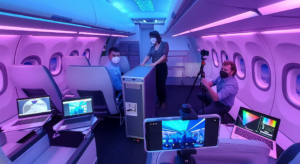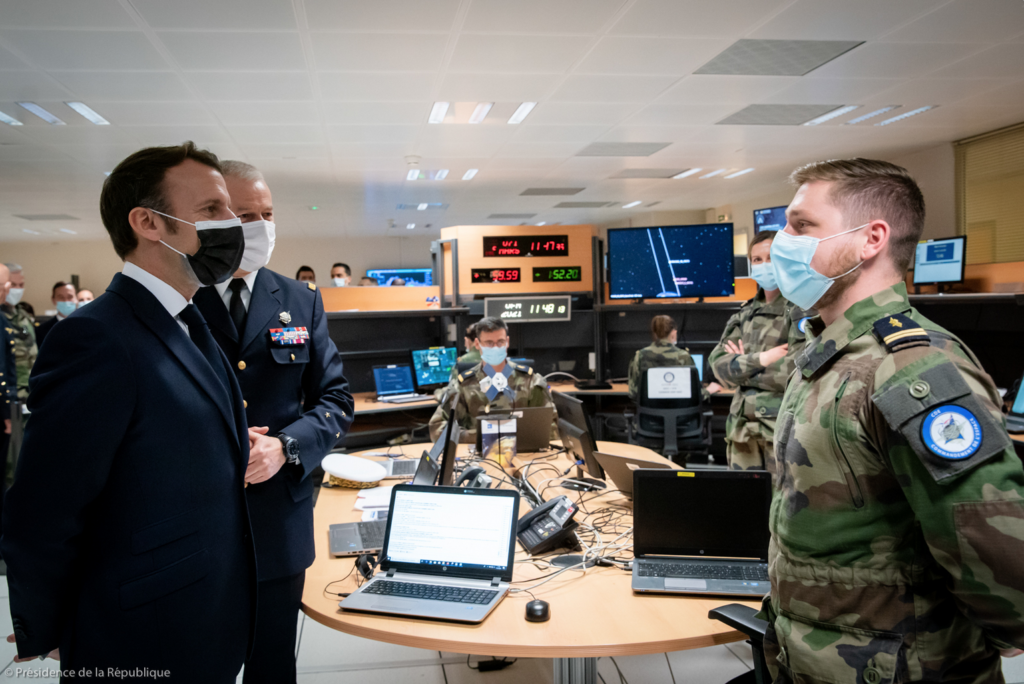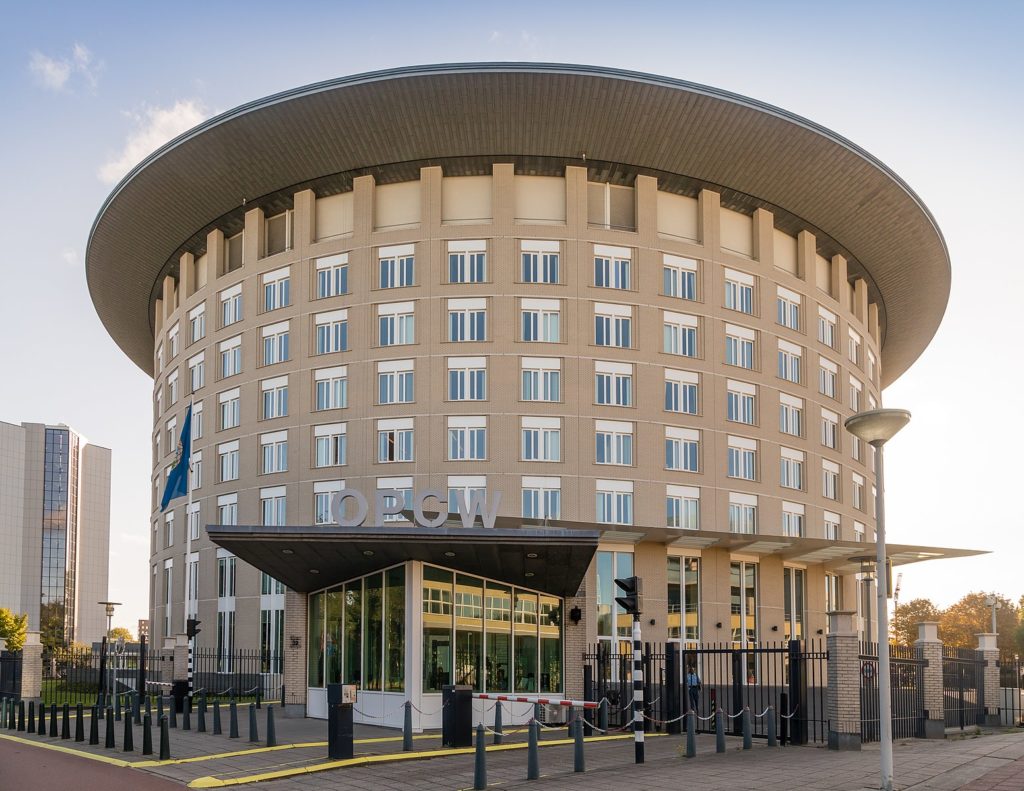DEFINING CABINS FOR CUSTOMERS – BUILDING A DREAM FROM A DISTANCE

“Testing cabin comfort, ambience functionality and lighting design is typically an emotional experience we offer our customers in the Cabin Definition Centre. Due to COVID-19 travel restrictions, the challenge we have faced is to re-invent the ways we interact with customers, providing the highest level of cabin definition in a fully digital way”, explains Alexander Jürs, Customer Service and Communication Manager at the CDC in Hamburg.
A virtual cabin definition experience
In close cooperation with Airbus’ subsidiary Testia and Information Management teams, the CDC was able to run customer definitions for the cabin, using a combination of virtual remote assistance, video conferences and live 3D Digital Mock-Up (DMU), when attendance in person was not possible. The combined solution offered by this partnership is available on smartphones and supporting digital devices enabling customers, suppliers and Airbus to perform many aspects of the cabin definition process on time, quality and without incurring additional costs.
In 2020, around a third of all CDC definition meetings have been managed virtually, with an overall customer satisfaction rate of 96%. Air New Zealand was one of the many airlines to benefit from the newly developed capability in the CDC. “Due to the pandemic and the need to continue development work remotely on cabin interiors. It is great to see Airbus thinking ahead on how the CDC can service the needs of the airlines. The remote live lighting session was excellent and very beneficial for us,” says Ed Collett the new Aircraft Programme Manager for Air New Zealand.
“In these difficult times, our customers are increasingly aware that our virtual live definition sessions are an efficient solution to reconnect all relevant stakeholders in one single digital place – even if they are looking forward to coming back physically in the CDC as soon as they can,” says Alexander.
2021 seems to confirm this trend and the remote solution developed by Airbus and Testia continues to smooth the customers’ cabin definition journey.
TRIPSET: THE COMPANION APP THAT HELPS AIR TRAVELLERS NAVIGATE DURING COVID
This mobile app gives the flying public real-time information for safe, healthy and smooth end-to-end journeys.
Air travel has become ever more challenging for passengers. Due to the COVID-19 pandemic, any attempt to reconnect to air-travel is countered by a myriad of varied – and often rapidly-changing – restrictions, making planning for any potential air-traveller difficult.
To help simplify the situation, Airbus developed the Tripset application as its contribution to rebuilding clarity and trust when travelling. The app provides the latest and most relevant up-to-date information covering all aspects of flight, from planning, booking, check-in to conditions while onboard and at the destination.
This new digital experience is based on the award-winning iflyA380 travel app, with everything at the user’s fingertips in a single application that is updated twice daily.

Hassle-free access to the latest travel information
The Tripset app aggregates information from multiple sources, including guidelines from government websites and embassies on in-country conditions, region-by-region restrictions or requirements, along with health measures implemented by airlines and airports.
Another important feature is the border status of destinations around the globe: whether they are open, restricted or closed. Also included are suggestions for ground transportation at the points of departure and arrival, such as commuting options to and from airports.
All this information is provided in an agnostic manner; no matter the airport, airline, flight number or aircraft type…the app will take into account the full range of available inputs.
How to fly again soon
Once a flight is booked, the passenger can import the trip specifics into Tripset, which then builds a personal timeline using all available data on the end-to-end travel conditions.
The app continues to provide information – even prompting the passenger when it is time to go to the gate, based on information from the boarding pass.
The free-of-charge Tripset app for Android and iOS devices is downloadable from Google Play and the AppStore.
“ASTER X 2021”: FIRST SPACE EXERCISE IN EUROPE
Last month marked the launch of the first space exercise in Europe: “AsterX 2021”. Led by the Space Command (CDE) of the French Air and Space Army (AAE), this tactical and operational training exercise for military space operations took place over several days at the National Centre for Space Studies (CNES) in Toulouse.
“You are space fighters.” Thus Colonel Christophe Michel, director of the “AsterX 2021” exercise, ended his speech for the launch of this first edition. In front of him were some 60 participants made up of space operators, ready to begin their training, and the exercise facilitation, planning and support team.

All CDE operational units participated in the exercise: the Space Operations Command and Control Center (C3OS) in Paris, the Military Satellite Observation Center (CMOS) in Creil, and the Operational Center for Military Surveillance of Space Objects (COSMOS) in Lyon. They all worked closely together with the CNES, industry players and German and American partners.
On the occasion of “AsterX”, a new simulation architecture was designed to reproduce the operational systems used by operators on a daily basis. This simulator combines a database made up of 10,000 space objects, 5 operational applications, the generation of 18 space events and an original time management approach allowing to condense 4 actual weeks into 4 days of training.

Gathered in the same operations room, the participants were confronted with complex but realistic situations. About 60 participants consisting of space operators and teams dedicated to the planning and support of the exercise were present.
During these exercises, a scenario specially devised for “Aster X” imagined a situation where, in the middle of the Atlantic Ocean on a fictitious continent, a geopolitical crisis gradually escalates between two regions. One of them is supported by France and its allies. Space Command units are mobilising with their partners to monitor activity and respond to potential space attacks. “During this crisis between two regions, explains the director of ‘AsterX’, the objective was to cover all types of space events. Operators had to deal with – for example – anti-satellite weapons fire, space rendezvous or even solar weather phenomena.”
The name “AsterX” was not chosen at random. First of all, it refers to the first French satellite launched by a Diamant rocket. It is also a nod to the famous Gaul depicted in the comics.
‘REASONABLE GROUNDS’ TO BELIEVE SYRIAN MILITARY HELICOPTER DEPLOYED CHEMICAL WEAPON: OPCW
A report released by the body dedicated to freeing the world of chemical weapons, concludes that there are “reasonable grounds” to believe that a Syrian military helicopter carried out a chemical attack on the town of Saraqib, in 2018.

The UN-backed international Organisation for the Prohibition of Chemical Weapons (OPCW) released the findings of the second report by its Investigation and Identification Team (IIT), saying that “at least one cylinder” of deadly chlorine gas had been dropped on the night of 4 February, spreading “over a large area” and affecting at least 12 Syrians on the ground.
‘Intolerable’
Questioned by reporters at UN Headquarters in New York about the report, the UN Spokesperson said that Secretary-General António Guterres had received the report, “and is deeply concerned by its findings. “The Secretary-General strongly condemns the use of chemical weapons and reiterates his position that the use of chemical weapons anywhere, by anyone, and under any circumstances, is intolerable, and impunity for their use is equally unacceptable”, said Stéphane Dujarric.
“It is imperative to identify and hold accountable all those who have used chemical weapons.”
The report states that although nobody was killed, a dozen people had been treated for symptoms of chemical poisoning, after the Syrian air force helicopter “under the control of Tiger Forces” had dropped a cylinder, which “ruptured and released” the chlorine.
Syria uncooperative
In its general conclusion, the IIT states that although it is aware of general information related to Syrian government investigations that “could be relevant to the use of chemical weapons”, it had not obtained or received information from the Syrian authorities “though it requested it”, which is a breach of the Chemical Weapons Convention. Neither did the IIT uncover any information indicating that “rogue units or individuals” could have been responsible for chemical weapons use in the 2018 Saraqib attack.
The OPCW investigation team is responsible for examining all evidence that can be gathered on alleged attacks in Syria, including interviews with witnesses, once the body’s Fact-Finding Mission has determined that chemical weapons have been used or likely used. The IIT released its first report a year ago, asserting that the Syrian military had used the nerve agent Sarin and chlorine gas, in two attacks on the village of Ltamenah, in March 2017.

OPCW background
As the implementing body for the Chemical Weapons Convention, the OPCW, with its 193 Member States, oversees the global endeavour to permanently eliminate chemical weapons. Since the Convention’s entry into force in 1997, it is the most successful disarmament treaty eliminating an entire class of weapons of mass destruction. More than 98% of all declared chemical weapon stockpiles have been destroyed under OPCW verification
Investigation and Identification Team (IIT)
The Organisation for the Prohibition of Chemical Weapons’ (OPCW) Investigation and Identification Team (IIT) is responsible for identifying the perpetrators of the use of chemical weapons in the Syrian Arab Republic. The IIT identifies and reports on all information potentially relevant to the origin of those chemical weapons in those instances in which the OPCW’s Fact-Finding Mission (FFM) determines or has determined that use or likely use occurred, and cases for which the OPCW-UN Joint Investigative Mechanism (JIM) has not identified the perpetrators of chemical weapons use in Syria. The IIT is comprised of a multi-disciplinary team of staff, which includes experienced investigators, analysts and a legal adviser who are led by a Coordinator. The team conducts its activities in an impartial and objective manner. The IIT is part of the OPCW Technical Secretariat and functions under the authority of the OPCW Director-General. The Technical Secretariat provides regular reports on its investigations to the OPCW’s Executive Council and to the United Nations Secretary-General for their consideration.
OPCW by the Numbers
193 States committed to the Chemical Weapons Convention • 98% of the global population live under the protection of the Convention • 98% of the chemical weapons stockpiles declared by possessor States have been verifiably destroyed
EXOSONIC AWARDED CONTRACT TO DEVELOP LOW-BOOM SUPERSONIC EXECUTIVE TRANSPORT AIRCRAFT CONCEPT FOR US

Exosonic, a low-boom supersonic aircraft manufacturer, has partnered with the U.S. Air Force’s Presidential and Executive Airlift Directorate (PE) to develop a supersonic executive transport. Exosonic’s aircraft can provide top US leaders and diplomats rapid transportation around the world to meet with world leaders or react to developing situations on the ground. By utilising Exosonic’s boom softening techniques, the passengers can travel overland and overwater at supersonic speeds, pending regulations, to roughly reduce their cruise times in half compared to existing aircraft.
In response to Exosonic’s award, Brig. Gen. Britton, Program Executive Officer of PE stated, “The Presidential and Executive Airlift Directorate is extremely excited to team with Exosonic on our quest to transform the future of executive airlift. As always, we are proud to be leading the charge to deliver cutting-edge technology to the world. Transporting key decision makers and teams around the world in half the time can be the difference between success and failure. Exosonic is a key player in getting us there. By teaming with industry, we are proving the United States Air Force can deliver technology leaps while maximizing return on taxpayer investment.”
PE’s contract, sponsored by the Air Force Research Lab, will support Exosonic’s efforts to develop and modify the company’s commercial supersonic airliner to serve as an executive transport vehicle. These modifications will include reconfiguring the aircraft cabin to include the required accommodations, communications equipment, and security measures that allow US leaders and their guests to work and rest onboard the aircraft.
“The future for global rapid passenger travel is low-boom supersonic flight. Low boom allows travelers to fly at supersonic speeds without generating disruptive booms for those on the ground,” said Norris Tie, CEO of Exosonic. “Exosonic is excited to win this contract as it represents not only commercial but government promise for low-boom supersonic travel.”
About Exosonic
Exosonic is an early-stage company developing a Mach 1.8, 5000 nmi range, 70 passenger supersonic airliner to fly overland with a muted boom. Exosonic believes that low-boom supersonic flight will be the next inflection point in commercial aviation, allowing people to fly around the world in roughly half the time.
THE NORTH KOREAN “HOTEL OF DOOM” IS STILL WAITING TO OPEN SINCE MORE THAN 30 YEARS

Located in the capital Pyongyang, the 105-floor Ryugyong Hotel over this 330 meters (1083 feet) high with 3.000 rooms has been described by The Guinness Book of Records as the world’s tallest empty building.
The hotel who was due to open in 1989 was to have a bowling alley, a nightclub and five revolving restaurants at the top. It soon became obvious that the 1989 target would not be met and it was decided that the hotel was only going to open in 1992, to celebrate the 80th birthday of Kim Il-Sung. By then the construction had cost around $750 million, the equivalent of 2 percent of North Korea’s GDP.
From 1992 to 2008, construction works where suspended and to the embarrassment of the Korean leaders the building looked abandoned. With the help of an Egyptian company, some construction resumed during the following years with the Korean Government entering in negotiations with the Kempinski Group, hoping to open it in 2013 for business. The deal never concretise. Since then the “Hotel of doom” is being used as a propaganda tool for the North Korean dictator Kim Jung Hun showing animations and movie scenes on a giant Led screen.
THE ROYAL BELGIAN INSTITUTE OF NATURAL SCIENCES NOW OPEN FOR VISITORS

In order to welcome visitors in the safest way possible, the RBINS has created a modular, one-way route through the Museum. Visitors can choose between a long route that includes all the exhibitions (Gallery of Evolution, Living Planet, 250 Years of Natural Sciences, BiodiverCITY, Gallery of Humankind, Dinosaur Gallery and Mosasaur Hall) or shorter routes that can be combined according to their wishes and the length of their visit. For people with reduced mobility and pushchair users: all routes lead through several staircases.
Tickets, priced at the ‘permanent exhibitions’ rate (€0-7), are available online only. A capacity tracker is in place in order to spread visits safely throughout the day.
The Museum has placed hand sanitiser dispensers throughout the visiting route and staff members are equipped with masks. The automatic lockers situated on either side of the (closed) cloakroom are available and are disinfected after each use.
Wearing a face mask (disposable breathing mask, fabric mask or scarf) when inside the Museum is mandatory from the age of 12.
The Royal Belgian Institute of Natural Sciences is a world-class research institute with more than 250 scientists and scientific collaborators covering a wide range of disciplines from biology to geology, oceanography to taxonomy and palaeontology to ecology. For their research, scientists and researchers often make use of our vast collections which contain almost 38 million specimens. They support national and international decision-makers with their scientific expertise and regularly publish scientific articles and reports.
The scientific staff are divided into three operational directorates and one scientific service: the OD Earth and History of Life, the OD Natural Environment, the OD Taxonomy and Phylogeny, and the Scientific Heritage Service, which is also responsible for the library.

Vautierstreet, 29
1000 Brussels
+32 (0)2 627 42 11
info@naturalsciences.be
OFFICIAL RANGE OF CHINA TO CELEBRATE THE 95TH BIRTHDAY OF HER MAJESTY THE QUEEN GOES ON SALE
A range of official chinaware produced by Royal Collection Trust has gone on sale to celebrate the 95th birthday of Her Majesty The Queen on 21 April 2021. Each item is made by hand in Stoke-on-Trent using methods and techniques that have remained unchanged for 250 years. From the development of initial designs and creation of individual moulds, to the hand-finishing with 22-carat gold and manufacture of the special packaging, the production process encompasses the skills of over 50 individuals from several factories at the heart of the English Potteries.
The central feature of the design is the Royal coat of arms above a garland of roses, shamrocks and thistles, the National Emblems of the United Kingdom, surrounded by pink roses. The design was inspired by the pink roses growing in the East Terrace Garden at Windsor Castle which bloom in June, the month of The Queen’s official birthday. The delicate border designs follow a l’oeil-de-perdrix or partridge-eye pattern, inspired by the decoration of Sèvres porcelain in the Royal Collection.

The official commemorative range includes a mug (£25.00), pillbox (£35.00), tankard (£40.00), side plate (£40.00) and teacup and saucer (£65.00). A range of limited-edition commemorative pieces will be introduced in the coming months.
A complementary range of traditional commemorative items has also gone on sale, including a corgi hanging decoration (£18.95), a tea caddy (£9.95) and cotton tea towels (£9.95 each) that are printed in Northern Ireland. Shortbread (£10.95) is made in Scotland, while rose and almond biscuits (£9.95) are made in Lancashire and sweets (£5.95) are made in Sheffield.
All profits from sales of the official chinaware range and commemorative items go to The Royal Collection Trust, a registered charity, for the care and conservation of the Royal Collection, and the promotion of access and enjoyment through exhibitions, publications, loans and educational programmes.
The china can be purchased online from www.rct.uk/shop, and will be sold in Royal Collection Trust shops at The Queen’s Gallery, Buckingham Palace and on Buckingham Palace Road, and at Royal Collection Trust shops at Windsor Castle and the Palace of Holyroodhouse, when non-essential shops reopen in England and Scotland.

